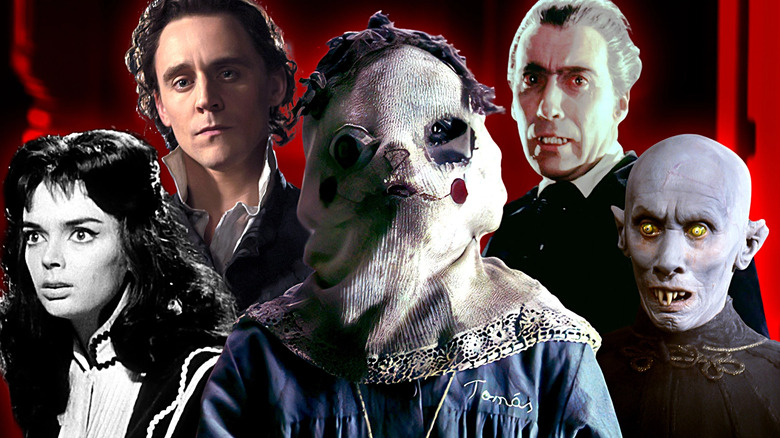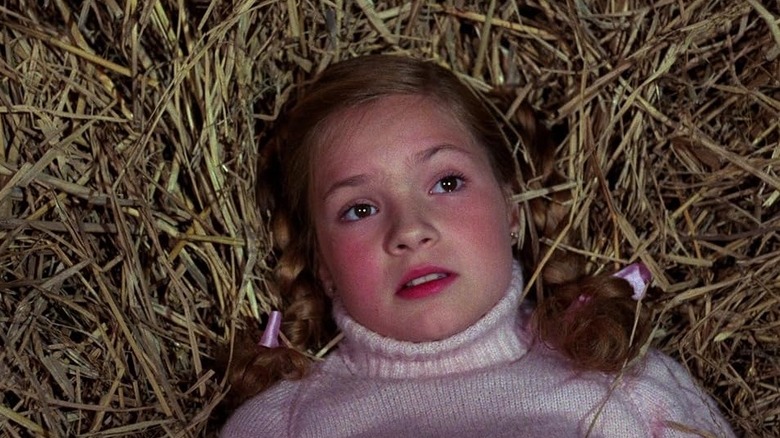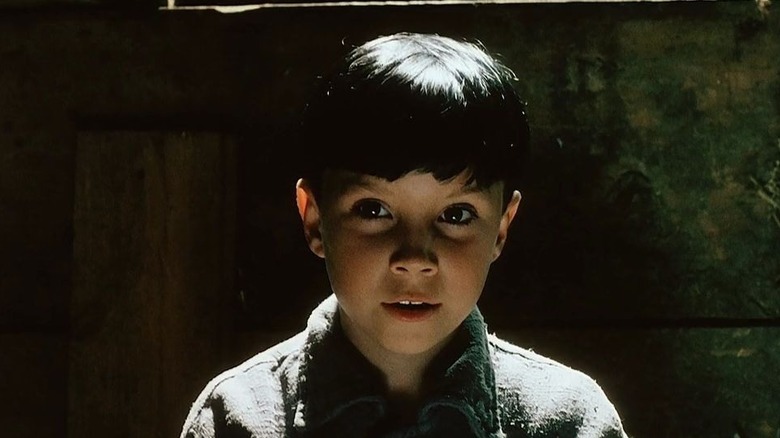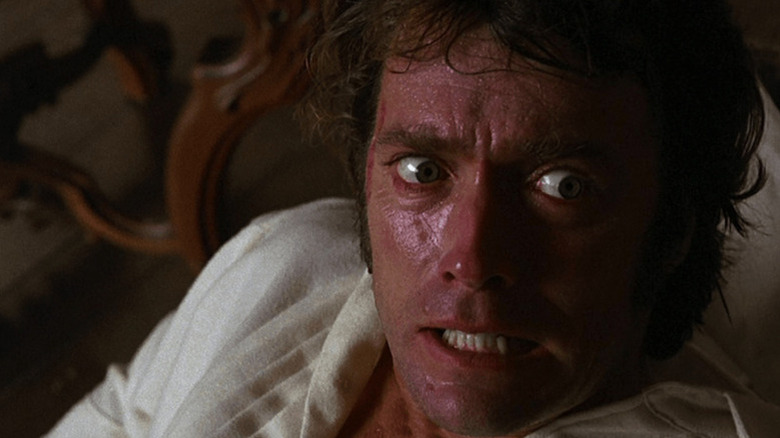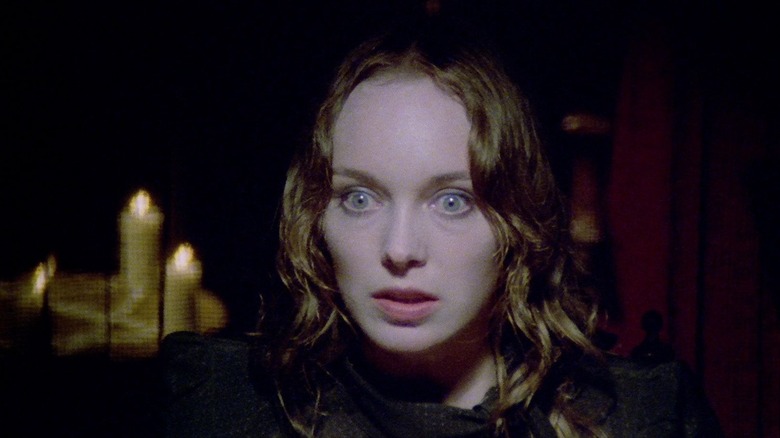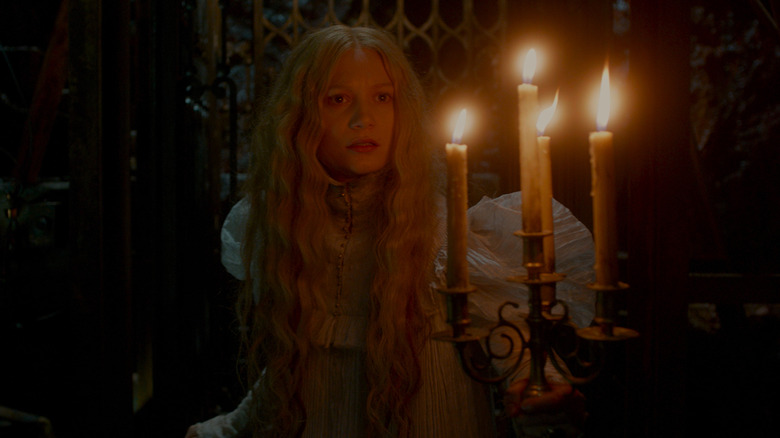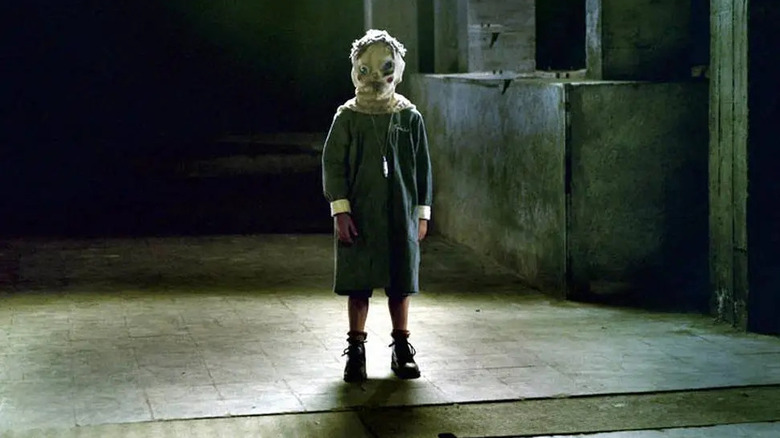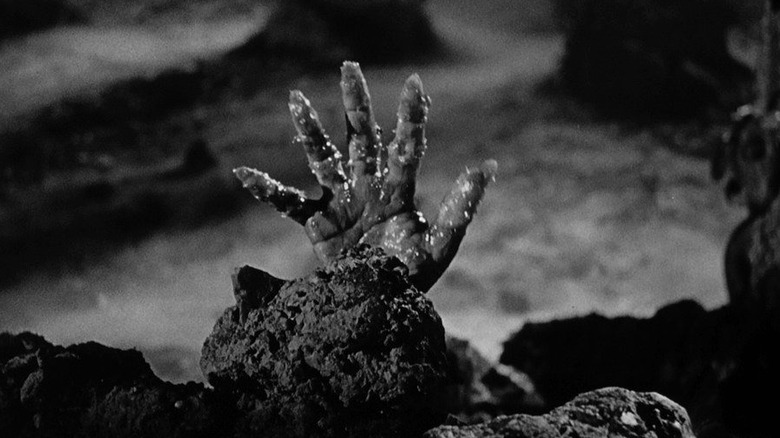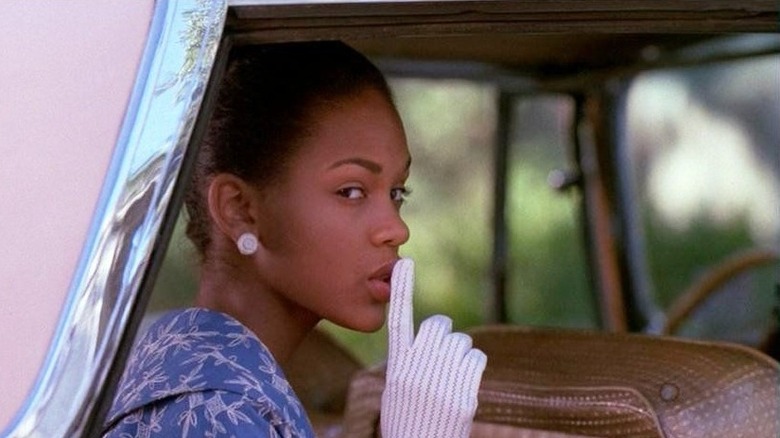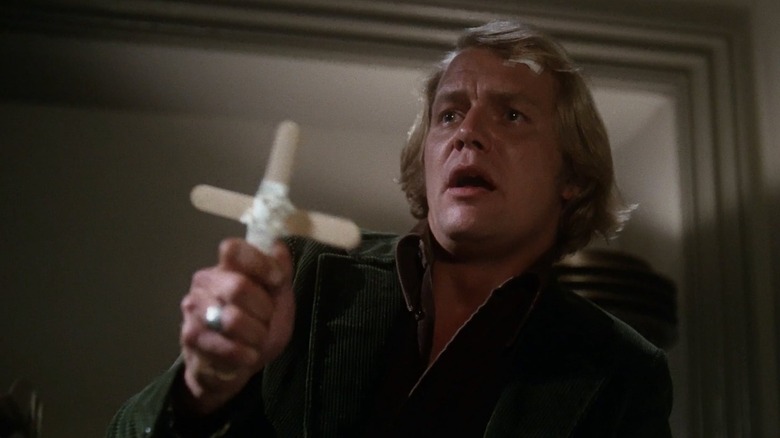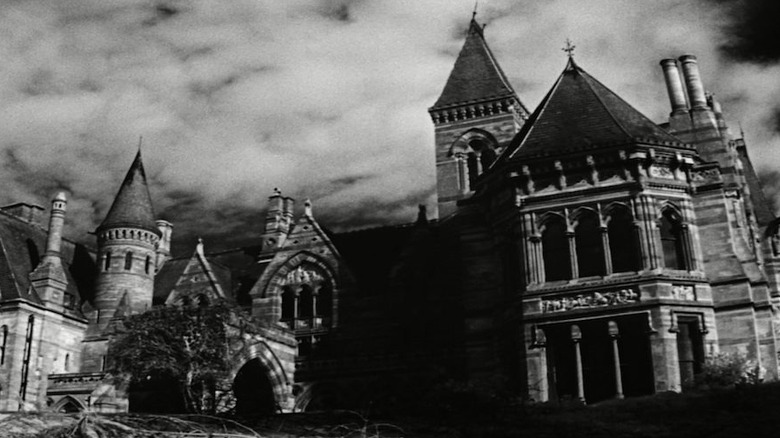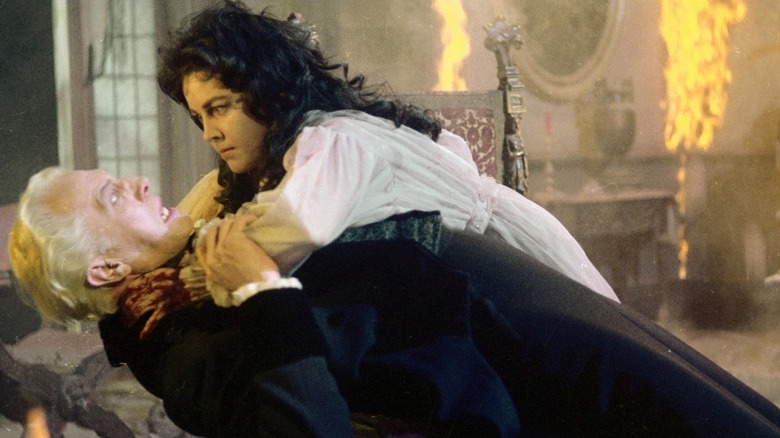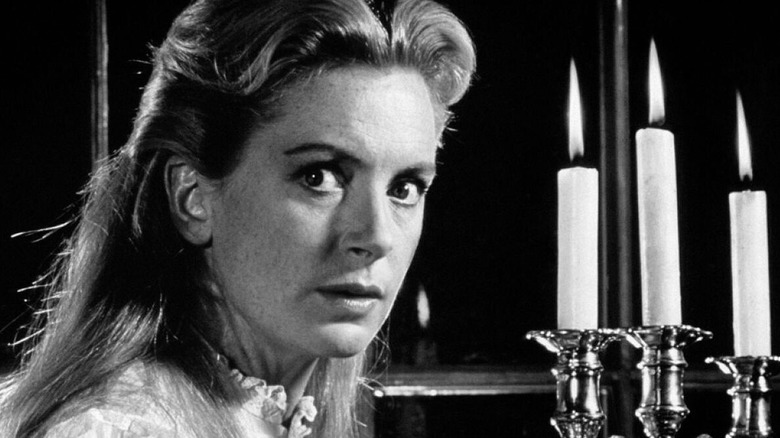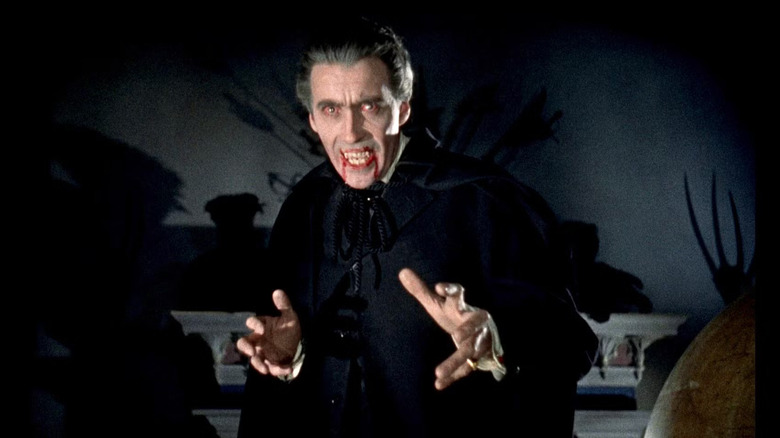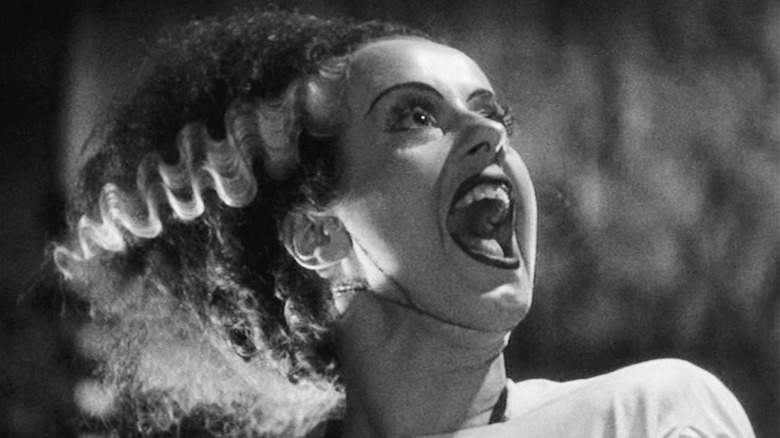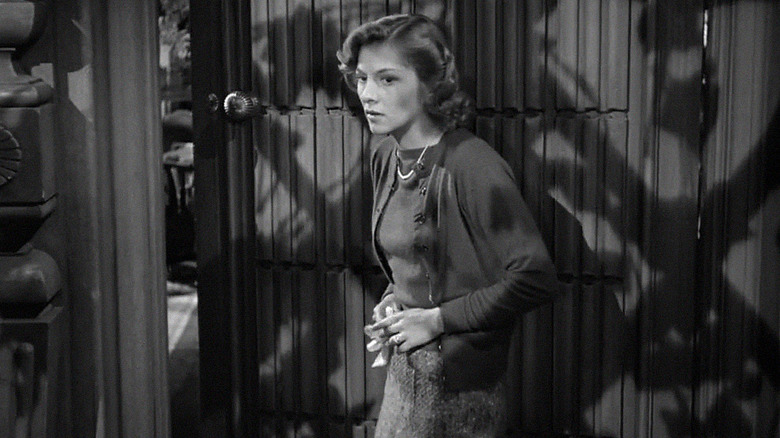The 15 Best Gothic Horror Movies, Ranked
We may receive a commission on purchases made from links.
While the term gothic was originally created in reference to architectural styles involving ornate designs and arches, it has since grown to find application with the entertainment arts and beyond. From romance novels to fashion, the term adds a suggestion of a darkly atmospheric touch, and that's especially apparent when it comes to gothic horror films.
Traditionally, a gothic horror movie unfolds in an old, decaying locale like a spooky old house or decrepit castle. Isolation is another key factor with locations that are geographically remote or cut off due to other circumstances, but that isolation can also apply directly to characters who are alone either literally or figuratively. Supernatural threats are common, but oftentimes merely the suspicion of something unnatural is enough. Stark contrasts are often present, and our narrators' beliefs may not always be reliable. There are numerous smaller elements that can come into play with gothic horror, but the remaining big one involves the weight and intrusion of the past into the present.
Given the broad range of factors that define gothic horror — as well as the existence of smaller subgenres like Southern gothic and urban gothic — it's likely that no two "best of" lists celebrating these films will look identical. Still, the 15 movies below are among the best gothic horror films, and all of them are worth watching.
Poison for the Fairies
A rundown Mexican villa is home to its own gothic horrors in Carlos Enrique Taboada's slow burn nightmare, "Poison for the Fairies." Veronica is an orphan living with her grandmother and desperate to impress the new girl at school, so she tells Flavia that she's a witch — and tries to prove it by orchestrating some increasingly dark events. Flavia is caught up in something magical, or so she thinks, and there might just be no going back.
Taboada crafts a deliciously unnerving coming-of-age horror film that finds various gothic influences throughout. Flavia is the duck out of water, a wealthy child raised atheist who finds herself immersed in a lower-class girl's supernaturally tinged world. The film highlights the girls' self-isolation by focusing solely on them, while adult faces are kept offscreen like some kind of nightmarish, live-action "Peanuts" cartoon — until one girl's obsession forces the other's hand. It's a disturbing descent that ends in a suitably shocking manner.
The Reflecting Skin
Like "Poison for the Fairies" above, Philip Ridley's "The Reflecting Skin" crafts a disturbing pairing of horrors both gothic and coming-of-age. While some people find themselves alone in a single room, Seth Dove feels isolated in a small, rural community in mid-20th century Idaho surrounded by endlessly open fields that promise a bigger world than the one he knows. He wants to believe in so many things, some innocent, others less so — including the idea that the weird woman in the creepy house is actually a vampire — but the harsh realities of life (and death) keep getting in his way.
The film's bright, sunny days, golden fields, and skewed glimpse of rural America feel like a knowingly dark wink towards Grant Wood's painting, "American Gothic." All of it works to create a sharp contrast against which Seth's journey of discovery unfolds as his old-fashioned surroundings reveal new secrets and lies. This is one of the more atypical gothic horror films on this list, but its themes feel right at home.
The Beguiled
As mentioned at the top, one of the offshoots from gothic horror is the southern gothic which finds its home strictly in the American south where themes of isolation, the past, and obsession are tied to others involving race, poverty, and an abundance of Spanish moss. The first of these to make the cut here is a 1971 collaboration between director Don Siegel and star Clint Eastwood. If you're surprised to discover that "Dirty Harry" is a southern gothic, well, it's because I'm actually referring to their other 1971 feature, "The Beguiled."
The Civil War-set film sees Eastwood playing a wounded soldier from the north who finds refuge in a rundown mansion being used as a school for girls. He gains their attention and affection as the only male, but it all spins quickly out of control as jealousy and madness — both fueled by a headmistress and teacher enduring their own sexual isolation — lead to deceit, torture, and murder. Sofia Coppola's 2017 remake is perhaps more artfully made, but it's missing the raw anger and hormonal horror of Siegel's film.
The Beyond
Gothic horror isn't exactly the first thing that people think of while watching Lucio Fulci's "The Beyond," but it remains the greatest slice of southern gothic horror ever made by an Italian filmmaker. On paper, at least, the setup feels very at home with the subgenre as a young woman arrives in rural Louisiana after inheriting an old, dilapidated and abandoned hotel. Inexplicable events start happening, and she learns too late that the hotel's sordid past has already doomed her future.
Fulci being Fulci, and "The Beyond" being his absolute masterwork and one of the best Italian horror films ever made, the unhinged madness spills onto the screen early and often. We get gory eye violence, bloody antics from the undead, a deceptively unhinged tarantula attack, and more grisly fun, all leading to one of the best and most nightmarish endings ever made. The past literally shambles into the present upending life and logic in the process, and it is glorious.
Crimson Peak
Guillermo Del Toro had touched on gothic horror previously, most notably with 2001's "The Devil's Backbone," but it's "Crimson Peak" that sees the horror legend celebrating the subgenre so thoroughly and effectively. It's 1901, and a proper young woman has married an eccentric inventor (Tom Hiddleston) in a union that sees her move to the man's elaborate but rotting home that he shares with his equally odd sister (Jessica Chastain). The house is home to violent secrets, and like the red clay bubbling up from the earth, they won't stay buried for long.
Del Toro's film ticks some boxes on the gothic horror checklist, but it's the production design that stands apart from the rest. Using both practical builds and digital effects, the film's central location, the house called Crimson Peak, becomes a living, breathing, bleeding character in its own right. Ghosts roam the halls — ghosts beautifully crafted using prosthetics effects and then enhanced with CG visuals — lushly decorated rooms share the screen with rot, decay, and structural instability, and past sins spill from every surface. It's a beautiful nightmare of a house.
The Orphanage
A big, spooky house already speaks to the kinds of horror that this subgenre embraces, but J.A. Bayona's film takes things a step further by revealing that the house was once an orphanage. See, kids are creepy, and that goes double when they're dead. The film follows Laura who moves with her husband and son to her childhood home where she was an orphan, and it's not long before a dark history is peeled back like old wallpaper. The hallways and crawlspaces hold secrets and pain that have a way of creeping into the present, and as Laura looks deeper into past shadows, the darkness prevents her from seeing the tragedy unfolding right before her.
Bayona's feature debut is a horror film displaying all the traits of a haunted house movie thanks to the atmosphere and scares that the filmmaker creates. Gothic horror elements fine tune the chills as loneliness and trauma combine with emotionally devastating weight. Several of the films on this list pull at your heartstrings, but "The Orphanage" straight up crushes it.
Black Sunday
Mario Bava's filmography features tales drenched in atmosphere, style, and color, but it's his black & white (solo) feature debut, "Black Sunday," that remains a monumental masterpiece of gothic horror (and you might find it streaming on Tubi). A woman is accused of witchery and entombed with a spiked mask pounded into her face, but two centuries later she's awakened to seek out a long-awaited vengeance. The film unfolds in constant contrast between the violent, ugly horrors of the witch's vengeance and Bava's eye for striking visuals and cinematic beauty.
From a dark crypt to the witch's ancient and abandoned castle, from landscapes shrouded in fog to grisly violations, the film employs gothic trappings paired with Bava's roving, hunting camera to create a constant feeling of threat. Barbara Steele mesmerizes as both the witch and her own descendant, and her performance walks a fine line between sanity and madness. The castle's interior celebrates decay as a fitting reflection of the evil and rage gnawing endlessly at the witch's soul.
Eve's Bayou
Eve is a young girl living in 1960s Louisiana, and while her affluent Black family seems to have it all, she begins to suspect something despicable beneath the surface. While things look prosperous, loving, and calm to outsiders, the truth in "Eve's Bayou" is anything but. Eve is haunted emotionally by things witnessed and things heard, and her obsession with righting what she sees as wrong — through an irreversible, supernaturally fueled punishment — can only lead to more pain.
Kasi Lemmons' feature debut as writer/director is a landmark in Black cinema (and one of the best horror movies from Black directors) for numerous reasons, including its depiction of its core family and its specific genre leanings. From the atmosphere and architecture to family secrets dredged up from the swamp, the film explores trauma and truth through a genre lens with a central protagonist whose own beliefs might not be entirely accurate either. It exists as a beautifully haunting piece of southern gothic horror.
Salem's Lot
Stephen King's second published novel is easily labeled as a vampire book, but it's also one of the great American gothic horrors — and it's first adaptation for the screen is equally fantastic. Tobe Hooper's "Salem's Lot" miniseries (one of the best adapted from King's work) is the way to go, but it succeeds at introducing, exploring, and destroying its small town setting even in its shorter feature form. King takes the idea of Dracula/Nosferatu and drops it whole into a New England community complete with an old, unsettling house, characters discovering past evils, and an obsession blurring the line between life and death.
Its television budget and restrictions keep Hooper from going big with gore or set pieces, but the film's time spent building its characters and story succeed as suspense, scares, and atmosphere all build to a satisfying conclusion. There are some genuinely creepy scenes and emotional moments here, and the ending feels like a warm callback to the Bram Stoker's original novel in the best of ways.
The Haunting
Shirley Jackson's novel "The Haunting of Hill House" has been adapted to the screen a few times, including most recently as an excellent limited series from Mike Flanagan and Netflix. As a film, though, it's Robert Wise's 1963 feature "The Haunting" that best captures its gothic, ghostly horrors. Hill House's near century-long existence has seen it home to numerous deaths and rumors about supernatural goings-on within, so a team of parapsychologists and skeptics enter its doors to find the truth.
While Wise's film makes various changes from the novel, the key elements remain with the most relevant being the structure, mystery, and atmosphere of the house itself. Cold spots, deranged interior angles, stray sounds and voices — the house is alive with malevolence and vile mischief, and all of it works to unsettle characters and viewers alike. Is the house a nightmare come to life, or are its occupants simply falling victim to their own fears and imagination? Good question.
House of Usher
You can't talk gothic horror without mentioning one of its greatest literary practitioners, Edgar Allan Poe. And when you're talking Poe adaptations? Well, Roger Corman is your guy. Corman directed seven films based on Poe's writing, arguably his best films as a director, but it's the first that speaks strongest to the author's gothic horror sensibilities. "House of Usher," based on the short story "The Fall of the House of Usher," unfolds in a bleak and gloomy mansion belonging to the Ushers, adult siblings seemingly cursed through the generations to suffer from madness and self-imposed isolation.
Lush with color, heavy with dread, the film teases incestuous obsessions and morbid truths in and around the decaying mansion. Misshapen trees and rotten soil surround the house, and the Ushers themselves aren't that far removed with their twisted psyches and macabre infatuations. It's up to an outsider to identify the shared madness, but it comes too late for both the Ushers and the house itself.
The Innocents
Henry James' "The Turn of the Screw" is the basis for wonderfully effective gothic horrors of "The Innocents," a film that tantalizes with ghostly insinuation while finding equally satisfying psychological explanations as well. Like "The Haunting," it offers arguments both for and against supernatural occurrences, an ambiguity that speaks to the film's longevity and the praise from fans like Martin Scorsese. What's undeniable, though, is the craft that director Jack Clayton demonstrates in bringing the gothic horror elements to life.
Our guide is a young governess who begins to suspect ghostly presences and indecent acts involving children isolated from the outside world, but her own state of mind could very well be the culprit. Sexual repression does no one any good, but is it enough to convince her that ghosts are real and possessing the children in her care? Clayton's black and white visuals play brilliantly with shadows as camera movement and angles suggest something is dangerously amiss, but the nearly empty mansion remains tight-lipped.
Horror of Dracula
You could make the case for any adaptation of Bram Stoker's "Dracula" to take a spot on this list, from Universal's 1931 classic to Francis Ford Coppola's decadent 1992 feature to Robert Eggers' recent nod to old-school gothic cinema, but it's Hammer's first go at the Count in 1958 that we're celebrating here. "Horror of Dracula," a U.S. retitle of the UK's "Dracula," is the first of seven films that the UK's Hammer Films made with Christopher Lee wearing the fangs, and it's a triumph of garish colors and gothic horrors.
Dracula's castle finds dark beauty in decay and lush production design, and Peter Cushing's Van Helsing becomes rightfully obsessed with bringing the vampire down. Through it all, Lee and director Terence Fisher allow the character and film to embrace their sexual cravings — within reason, of course — as a contrast to the stuffy restraints of the Victorian era. Fisher's camera glides effortlessly throughout giving vibrant, vivid life to one of gothic horror's greatest tales.
Bride of Frankenstein
Mary Shelley's novel, "Frankenstein, or the Modern Prometheus" remains one of the all-time classic tales of gothic horror, and James Whale's adaptation manages the same feat for the screen. His sequel, though, is the superior film and even succeeds at amplifying and elevating the gothic horror elements. It seems the good doctor and his monstrous creation survived the villagers' fiery assault and have gone their own ways, but while the former is looking to reform his ways and get married, his creation is looking for a companion of his own.
Whale once again contrasts crumbling architecture with slick, high-tech machinery and scientific ambition with shaky morality, but he turns things up to eleven with the arrival of the bride. She's both an expressionistic creation with her gravity-defying, lighting-struck hair, and a twist on the traditional gothic female protagonist in that she exists at the whim of her male creator while still retaining the agency to resist the approaching horror.
Rebecca
While Alfred Hitchcock's "Rebecca" might feel slight compared to some of the horrors above, it secures the top spot here as a brilliant, beautiful adaptation of Daphne du Maurier's novel and the epitome of gothic horror. Joan Fontaine plays a young woman swept up in a lavish romance with a troubled man named Maxim de Winter, but when she returns as his bride to his estate, Manderly, she discovers something dark brooding in both the house and in Maxim's past — namely, a previous wife whose death hasn't stopped her presence from being felt at every step and turn.
Innocence contrasted with the cruel and guilty, dark secrets from the past clawing their way into the present. A large mansion home to secretive misdeeds and deep shadows. A housekeeper obsessed with Maxim's first wife to an unhealthy degree. The suggestion that the deceased, Rebecca, might still roam the halls. A young woman made to feel isolated and alone in her new home — and a director who reportedly played up that element by encouraging the mostly non-American cast to keep Fontaine at a distance off-camera too. A romance turned nightmare, "Rebecca" is crafted and shot to build suspense and leave viewers feeling increasingly tense, and the result is a masterful example of gothic horror.
